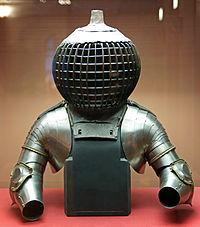Armor for the butt tournament
| Armor for the butt tournament | |
|---|---|

|
|
| Information | |
| Weapon type: | Protective weapon |
| Designations: | Piston tournament armor |
| Use: | Armor for the butt tournament |
| Working time: | 15.-16. century |
| Region of origin / author: |
Holy Roman Empire , armorer |
| Distribution: | Europe |
| Lists on the subject | |
The piston tournament armor is a late medieval tournament armor for the piston tournament .
description
→ Main article: Pistons tournament
Piston tournament armor is armor that consists of special parts and was developed for the so-called piston tournament. The piston tournaments were developed and held in the Holy Roman Empire of the German Nation from around the 15th century . In contrast to the other tournaments in which a lance was used ( Hastiludia ), special blunt maces and swords were used in this type of tournament.
The last significant piston tournament was held at the end of the four-country tournaments in Worms in 1487 .
weapons
The weapons were specially developed for the tournament and built differently from normal weapons. The sword was made of steel , but had no edge and no sharp point . At the end of the pommel was a ring that was used to secure the sword to the armor. However, these swords were very heavy, which meant that better arming options had to be found for this reason alone. The mace was made of wood and was about 80 cm long. The flask widened from the handle to the place. The cross-section was polygonal , the guard consisted of a circular sheet iron disc or a nodus (thickening) on the handle and the pommel was spherical. The use of these weapons for the tournament forced the armourers to redesign special parts of the armor.
Helmets
→ Main article: Piston tournament helmet
The helmets used up to then were strong enough to withstand the blows, but were so tightly fitted to the head when worn that serious injuries were the result. The new helmets or spherical helmets were made larger and spherical and only rested on the wearer's shoulders and chest. The head was not touched by the calotte. The visor or the viewing slit was replaced by a grid made of steel struts. In some versions, a wire mesh was incorporated in addition to the struts (see picture on the right). Among the helmets was a Coif worn (even Hersenier or tournament hood), through their strong feeding additional shock dampening effect. At the top of the helmet's apex was a metal pin or a small tube that was used to attach the Zimier .
The helmets were made in two different versions. One version consisted of a frame made of steel struts, which were covered with a cover made of boiled ("boiled"), strong cowhide. This leather was covered with lime and painted with tempera in the colors of the wearer. The second version consisted of a steel, forged calotte to which the grid visor was attached. A helmet cover, which was frayed ("zaddled") at the edges, was usually worn over the forged version. The helmets were fastened to the rest of the armor using iron straps that were attached to the hubs on the breastplate .
The so-called heraldic helmets have a similar shape, but they should not be confused with the piston tournament helmets .
Breastplate
At the beginning of the butt tournaments, the breastplate was made of boiled leather that was studded with heavy metal nails as a lentner . A heavy iron ring was attached to each side of the body, which was used to attach the weapons to the lentner with hemp cords and to protect them from loss during the fight. When plate armor came into use around 1440 , a breastplate was developed that was covered with holes. The perforation served for better ventilation of the breastplate to prevent overheating and excessive perspiration. On the chest and back, the pushed belly hoops came together and a leather apron was attached to the back of the buttocks.
Arm stuff
The Armzeug the piston tournament armor consisted of either leather or steel. Depending on the material used to build it, it had different looks. If the armor was made of leather, the armpits were made spherical and the armpits as well as the armpits were sewn with strong hemp ropes to reinforce the armchairs. The gloves were fingerless handles made of leather and reinforced with metal discs on the top of the hand and on the gauntlet . If a jump-off race was held before the butt tournament, a racing archery was tied to the left side of the breastplate, the straps of which were around the shoulder and chest. The shapes and the material of these tarts were different: triangular, square, concave, with spiral-shaped ends, wood covered with leather or sheet iron.
Individual evidence
- ^ Austrian Institute for Library Research, Documentation and Information, Franz Grasberger, Franz Hadamowsky, Franz Unterkircher, Albertina Graphic Collection, Biblos-Schriften, Volumes 21 – S25 , Verlag Österreichisches Institut für Bibliothekforschung, Documentation and Information, 1958, page 188
- ↑ Auguste Demmin, CC Black, An Illustrated History of Arms and Armor, Verlag Echo Library, 2008, ISBN 978-1-84830-049-1 , page 512
- ↑ Wendelin Boeheim, Handbook of Arms, Nachdr. D. Ed. Leipzig 1890, Fourier Verlag, Wiesbaden 1985, ISBN 978-3-201-00257-8 , pages 523-526
literature
- Matthias Pfaffenbichler, Christa Angermann: Maximilian I .: the rise of an emperor: from his birth to sole rule 1459-1493. MWN Verlag, Stadtmuseum Statutarstadt Wiener Neustadt, 2000, ISBN 978-3-85098-248-1 , page 82, 212.
- Peter Jezler , Peter Niederhäuser, Elke Jezler (eds.): Knight tournament. History of a festival culture. Book accompanying the exhibition in the Museum zu Allerheiligen Schaffhausen. Quaternio Verlag, Lucerne 2014, ISBN 978-3-905924-23-7 .

